Two years ago, I wrote an article for Business of Home looking at whether AI—artificial intelligence—was poised to impact the design industry. At the time, the technology on the market was intriguing but only useful under limited circumstances. I walked away feeling like we were years, maybe decades, away from a version of AI that designers needed to seriously think about. I was wrong.
If you’ve been following the news coming out of Silicon Valley recently, you already know this: We’re in the thick of an AI revolution. Chat-based tools like OpenAI’s ChatGPT have dazzled users with sophisticated answers to complex questions, while visual programs like Dall-E and Midjourney can produce shockingly good imagery, instantly. These tools are no longer confined to universities or back rooms at Google HQ. They’re consumer products, easy-ish to use and cheap (if not free). They’re here, they’re frighteningly good, and they will matter for the design industry.
Exactly how? It’s hard to know just yet, but in an effort to get a sense of the possibilities, I’ve spent the past week playing with AI tools. As it turned out, my timing was good. Last Tuesday, startup OpenAI released the long-awaited update to its signature product, GPT-4, a chatbot capable of writing code and passing the bar exam. A day later, Midjourney released its own upgrade, V5, a tool that has sent a collective shiver up the spine of illustrators and photographers alike for its uncanny ability to generate hyper-realistic imagery of almost any kind.
The conventional wisdom on new AI tech is that you should experiment to figure out how it could make your business more efficient. Designers are already doing that by using ChatGPT to formulate marketing ideas, write blog posts and Instagram captions. But I’m not a designer, so instead, I went looking for something a little more unsettling—how consumers will use these tools to try to circumvent the design industry. The results were startling.
ChatGPT is free, but the latest release, GPT-4, is only available with a Pro upgrade ($20 a month). I opted in and started playing around with the software, looking for design advice. ChatGPT’s interface is simple: You’re given a text box, you input a prompt, and the software answers. At first, I ran it through some common design challenges—how to make a small space feel bigger, for example.
ChatGPT gave a good if generic list of eight suggestions (“Utilize mirrors,” “Keep furniture low profile,” etc.). That was unsurprising. Its algorithm was trained by “reading” terabytes of data, mostly culled from the internet, and identifying patterns and statistical correlations. That ChatGPT can regurgitate simple advice from design listicles is not a shock.
It began to really impress when I started drilling down into specifics. “Imagine I want to completely redecorate my living room in a midcentury modern style,” I wrote. “The room is 300 square feet. Can you come up with a list of everything I’ll need to buy? Include stylistic suggestions, likely brands and a plausible price range for each item, as well as a total budget.”
ChatGPT quickly got to work—and the result was very, very good. In seconds, the algorithm specified my imaginary project, suggesting, among other things, “a sofa with clean lines, tapered legs and low profile” in a neutral color; a Saarinen side table; and a table lamp with a “bold color such as red or yellow,” by a designer like Louis Poulsen or George Nelson. Total budget? $10,000 to $25,000.
That an algorithm can come up with a list of furnishings that go in a living room isn’t necessarily mind-blowing. What surprised me was the brands it specified. ChatGPT had (correctly) guessed that I might find a “simple design, and a low profile” coffee table from Herman Miller to fit my midcentury modern scheme—that’s a more complex leap, one the algorithm made easily.
I threw a few twists at the algorithm, and ChatGPT parried each one of them. “Same idea, but this time look for more luxurious options, with a maximum budget of $100,000,” I prompted. The results looked like this:
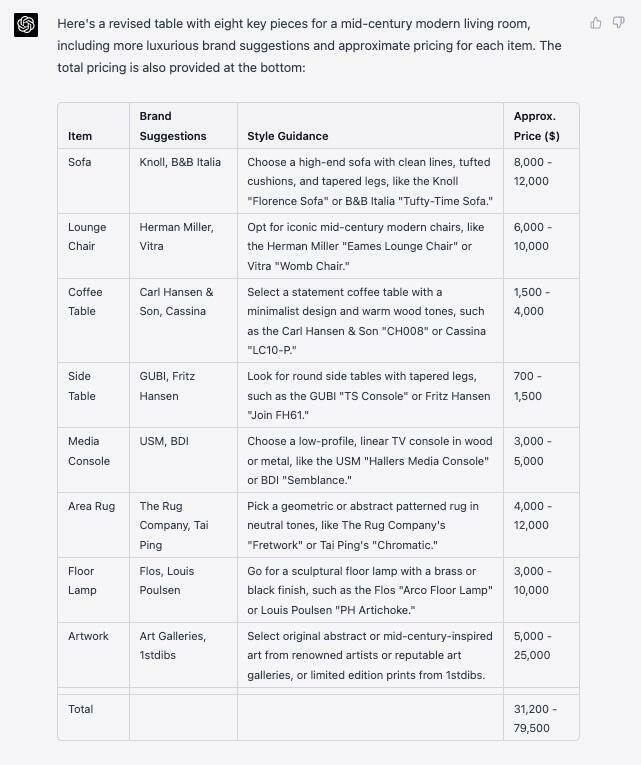
“Same budget, but instead of midcentury modern, make it traditional,” I prompted. ChatGPT specified a room full of “wood pieces and rich textiles,” ID’ing furniture brands like Ballard Designs and fabric houses like Schumacher and Kravet. “Include shipping and labor fees in the budget,” I tried. The algorithm came through.
Playing with the latest AI visual tools left me equally gobsmacked. One of the best currently available on the market, Midjourney, took a little bit of effort to get up and humming. The software requires you to set up an account on Discord, a social platform favored by the young and tech-savvy. Once you’re there, coaxing a result out of the AI takes more finesse than ChatGPT.
Midjourney prompts are a unique kind of language that, at first glance, can feel like an impenetrable mash-up of buzzwords: “Hyper-flat illustration style, corporate memphis, minimalist vector cartoon. A dog holds a birthday cake – aspect ratio 16:9,” for example. But with a little noodling, I was able to make the algorithm rapidly produce some seriously impressive renders.
AI has been decent at generating interiors for a while now, but Midjourney’s latest update is a definite leap forward. Earlier iterations were prone to oddities—tables with too many legs, windows to nowhere and bathrooms without sinks. Most of those quirks appear to be gone, and the quality has gone up dramatically. These are sharp, clear, stylized images that could go toe to toe with work by rendering firms.
Like ChatGPT, Midjourney is also good at correctly identifying aesthetics and style. I began by prompting the algorithm with simple requests, like “a midcentury modern living room,” which it handled easily with impressive results. I began pushing it a little, asking for “a living room that mixes old and new, in a green palette, with velvet curtains,” and “an eclectic living room in deep blue and burnt orange.” Midjourney generated results that felt true to both prompts:
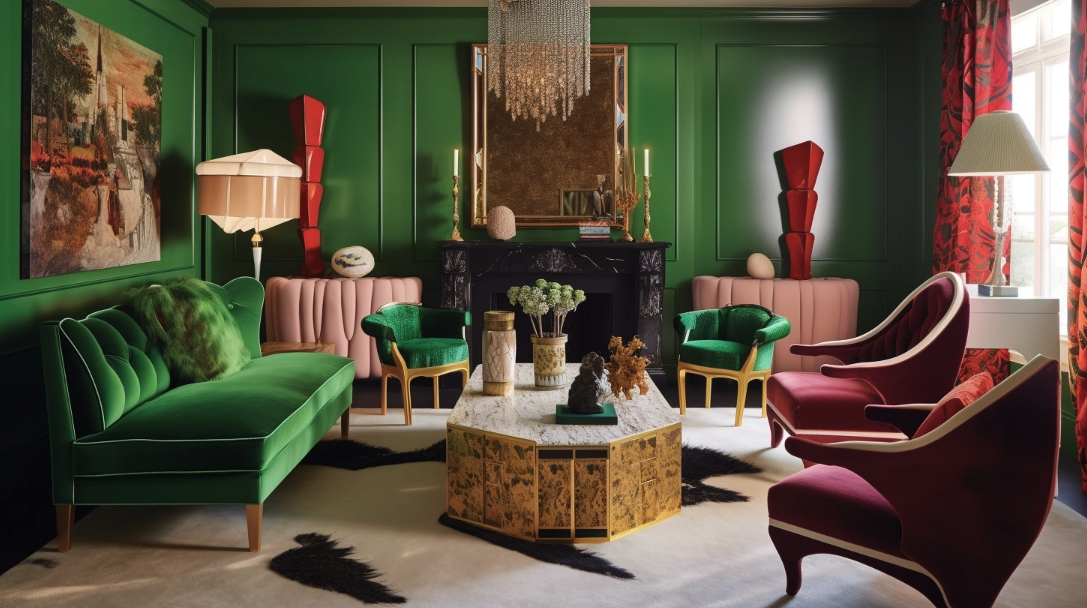
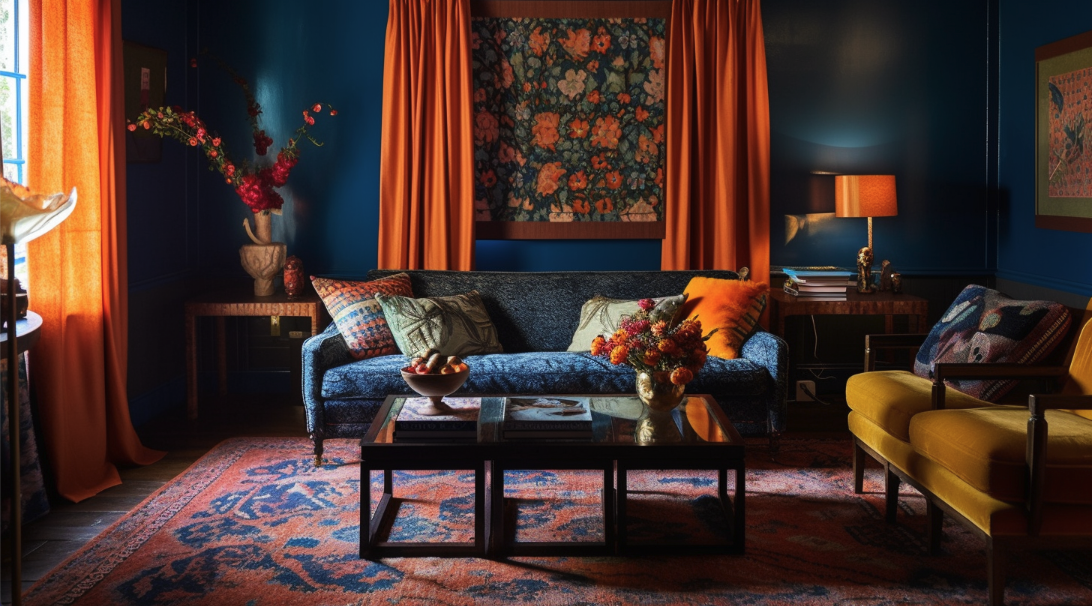
It also conjured compelling results for deliberately esoteric searches, like “an elegant Architectural Digest–level room for a witch coven meeting.”
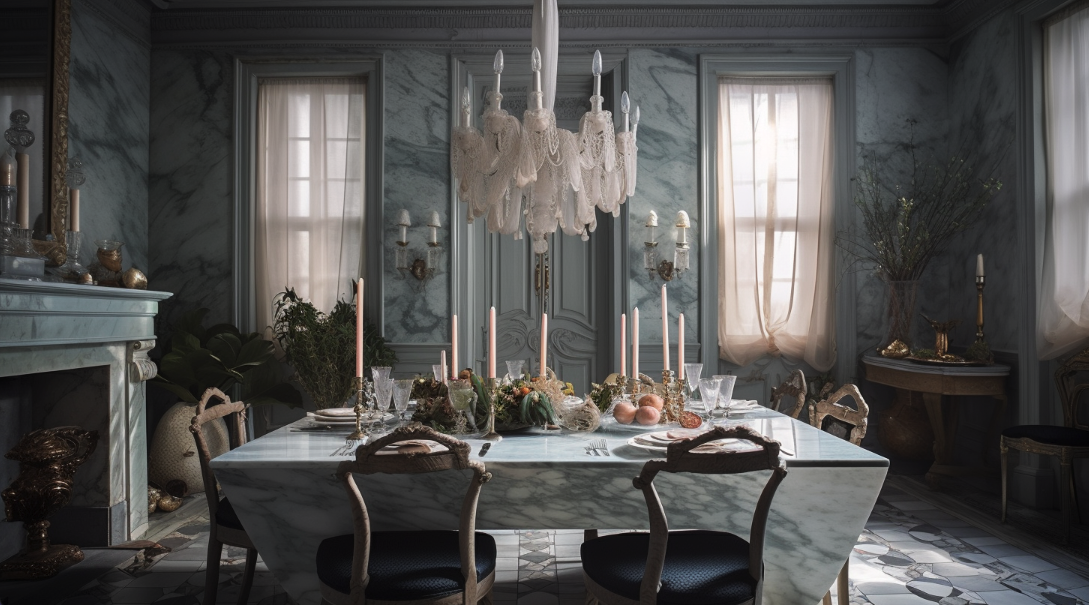
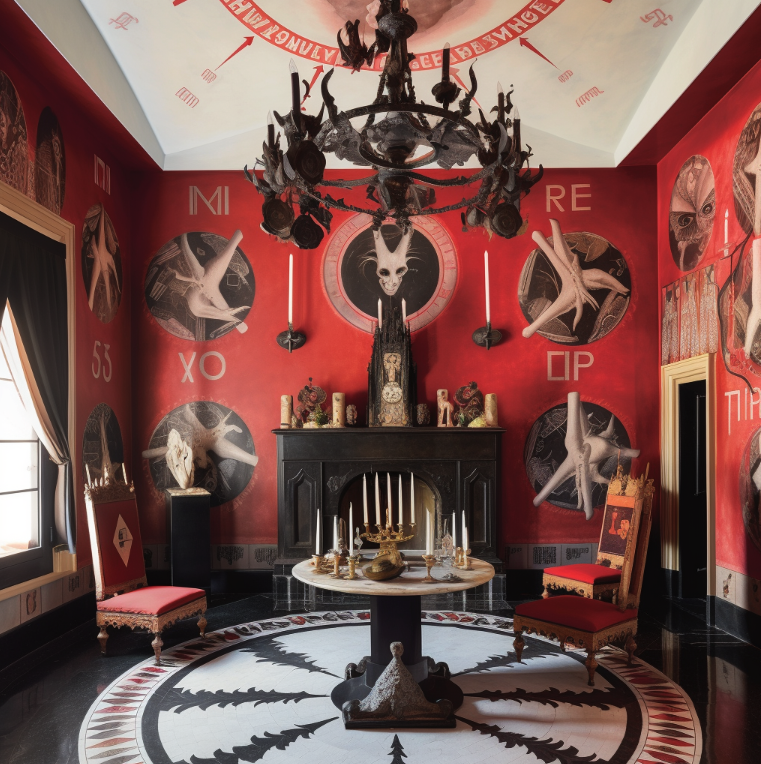
The same was true for hyperspecific searches like “a living room in a beachside home with large windows, a fluffy white sofa, a jute rug, abstract art and a fiddle-leaf fig” or “a welcoming country cottage with a crackling fire, paintings of horses on the wall, and plenty of toile.” In every instance, Midjourney was able to generate a great-looking rendering that satisfied every ask. Prompt after prompt, the algorithm came through.
Though these tools have extraordinary abilities, they also have some very real limitations. If you’ve read anything about ChatGPT, you probably know one of its core flaws: The algorithm doesn’t know if the information it is sharing is accurate. For some applications—like diagnosing an illness—that is a serious problem. But in using ChatGPT to help with decorating challenges, the stakes are inherently lower, and it largely provided what felt like good, helpful advice.
The more relevant challenge, I discovered, is that ChatGPT is not great at precision. It can give you a list of the kinds of things you’d need to redecorate your home, but struggles more in recommending specific pieces. To be clear, ChatGPT can certainly try. I asked it to generate a shopping list for a “grandmillennial-style living room,” and the algorithm suggested, among other things, the Lyre chesterfield sofa from Anthropologie and the Suzanne Kasler Gourd lamp from Ballard. But here, ChatGPT’s much-discussed accuracy problem reared its head. Some of the products it suggested aren’t for sale anymore, and some of the companies it recommended I shop from are out of business—GPT-4 doesn’t do shoppable links. These are significant limitations. It’s great to suggest a “sofa with clean lines and tapered legs,” but finding a great one you can get on a reasonable lead time can be a significant task.
The precision problem is bigger for visual tools like Midjourney. You can feed these programs images of your home, ask for a redesign, and the AI will cough up an impressive result without fail. However, the algorithm is not great at understanding the precise dimensions of the original room and does not hesitate to add windows, move walls or lower ceilings as it sees fit. You could use Midjourney’s creations as a jumping-off point, but you couldn’t hand them to a contractor and say, “Go.”
Likewise, Midjourney isn’t great at taking finite suggestions. Asking it to change just one thing (“Love the sofa, lose the pillows”) leads to uneven results—the algorithm is just as likely to start over from scratch. Finally, Midjourney is not filling its digital rooms with “real” product, but visual approximations of it. You can get a beautiful room, but you can’t click to buy.
These flaws are real. But given the incredible commercial incentive behind solving these problems, it’s likely that they will be temporary. Startups and tech giants alike are already working feverishly to come up with AI that leads consumers to real products—and more precise tooling is only a matter of time. In the very near future, we will be able to quickly scan a room with our phones, ask it to re-imagine the space as “cottagecore inspired,” and get a pretty good rendering and a shoppable list of products (that will fit). That’s not science fiction. That’s next year.
The second area where AI comes up short is more subjective but no less important: These tools are not that creative. If you feed an algorithm a million pictures of a midcentury sofa, it can spit out an image that looks like a midcentury sofa. But if you ask it to come up with unexpected-yet-attractive twists on the form, it struggles. I spent 10 minutes with ChatGPT, trying to get it to give me “unique, personal, unexpected design ideas,” and the best it could do was suggest using a stack of vintage trunks as a side table. Impressive for a robot, but hardly groundbreaking.
That weakness will be reassuring to those who rely on creativity to keep food on the table. But it would be dangerous to assume that AI will never improve in that department (after all, what are new ideas but old ideas, artfully remixed?) or that a lack of innovation will even matter for every consumer. For every client who wants their life reflected in every drawer pull of their home, there’s another who sends over a Pinterest board and says, “Give me something that looks like this.” AI is arguably good enough to do that already.
If any of the above makes you feel a little worried, that’s normal, and probably healthy (I’m a writer, and I’m terrified). But designers should know that their profession comes with a kind of built-in resilience to artificial intelligence: It takes place in the messy, emotional, imperfect real world.
It’s long been an open secret of the industry that renderings and shopping lists are only 10 percent of any project, and that much of the job is in its execution. Getting the contractor to show up on time; sit-testing the sofa and touch-testing the fabrics; wrangling difficult spouses and children; dealing with damages, deadlines, breakdowns, setbacks and surprises of all kinds—none of that can be done by software.
The vibe of home, too, will provide protection. Most of us will welcome AI help when it comes to filing our taxes or sorting through spam emails, but for deeply personal tasks, it’s human nature to seek connection. For most clients, the process of working with a great, empathetic designer adds to the pleasure of the final result.
In other words, it’s not the moment to panic—far from it. But the time to start thinking about how AI will impact your corner of the industry is now.
Homepage image: A midcentury modern rendering by Midjourney | Courtesy of Midjourney




























